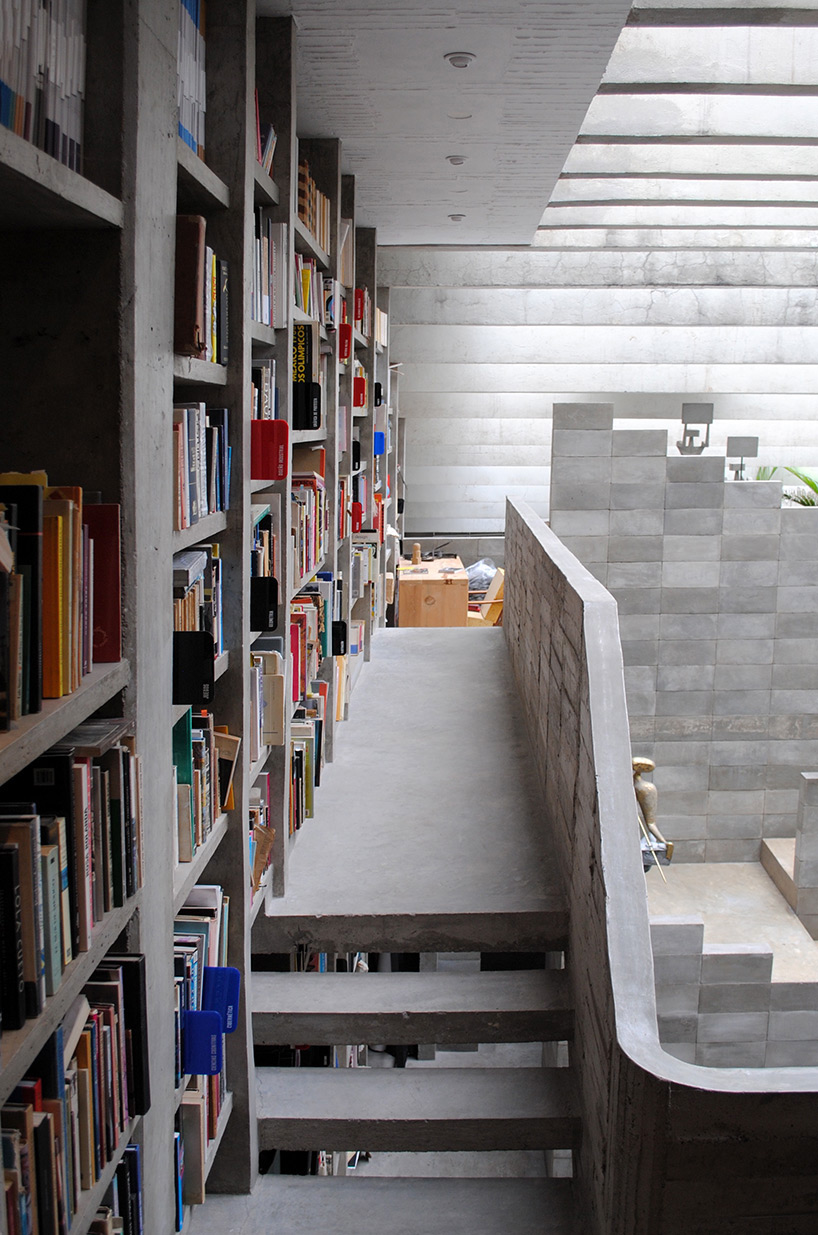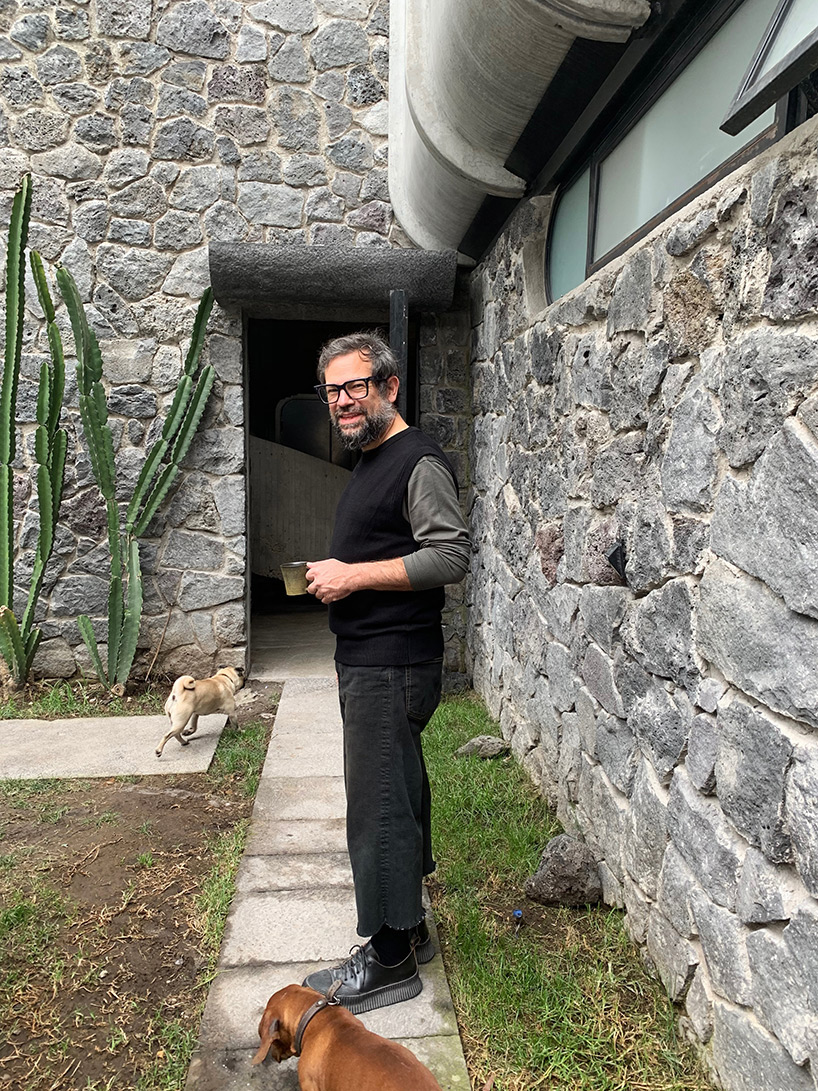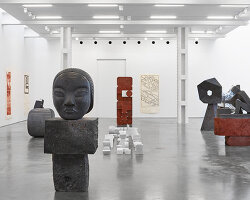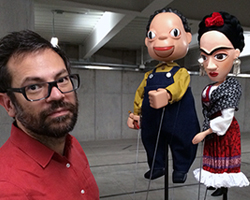artist pedro reyes and fashion designer carla fernández — the cross-disciplinary creative couple from mexico — focus on different practices, yet express similar themes and concerns across their work. the pair often tackles topics such as social values in communities, mexican indigenous cultures, and human interaction in the digital age. reyes and fernández also often work on projects together, including the recent production of a graphic identity for design miami/ 2018, as part of winning the fair’s coveted visionary award last year.
their home in the capital city is an ever-evolving architectural and interior project — the product of both artists’ input, influences, and ideas. wrapped in shelves that accommodate a vast library of volumes and tomes, and punctuated by the couple’s own creations throughout, the dwelling is a built expression of both reyes and fernández’ aesthetic ideals. while in mexico, designboom met with pedro reyes at the home — which also houses his art studio — to speak about his latest projects, his approach to public art commissions, and his continuation of the tradition of craftsmanship.

image © designboom
designboom (DB): what are your big, upcoming projects? what are you currently working on?
pedro reyes (PR): I’m doing a sculpture, different commissions for both public and private in this context. one of them is a sculpture and public commission for the city of san antonio, texas, which will mark the 300 year anniversary of the city. it’s interesting, because the city is older than the united states and older than the formation of mexico’s state. back then, that territory was new spain, but the city is celebrating its foundation. they asked me to work on this public art commission, which was interesting for me, because I was able to take the language of stone carving back into contemporary art.

image © designboom
PR (continued): in mexico, we’re sitting on a tradition of sculpture that dates back 5,000 years. there’s a lot of craftsmen that keep the traditional skills of stone carving alive, but still a lot of these got lost. to have the foundation of a huge heritage and these living skills was something that attracted me to continue this practice of sculpture, because I come from a conceptual art practice that started about 30 years ago. then, I did a lot of social projects, and theater, and many diverse practices — but now I’m doing something that will be in a public space, and it’s meant to stay in very good condition well into the future, so stone is the best material that you can use.

image © designboom
DB: the idea of the monument: once it was very celebrated — somebody who was in power wanted to show others that he was superior. what would you say is the sense of a contemporary monument today?
PR: I think that monuments have been heavily criticized by contemporary art. it’s something that there’s also mixed feelings about, because as much as it has been a target of criticism, it’s also something that continues to survive. for instance, in this particular case, considering that the work that I was asked to do was to mark the kind of formation of a celebration of 300 years, what I wanted to talk about is actually that this territory was inhabited 9,000 years ago by the original settlers of the continent. the sculpture that I’m doing is actually not so much about the firm foundation of the city, but about reminding people that the nation states, the divisions we have between the united states and mexico, are relatively recent in the scope of time. also, the native american groups that settled before this nation state were there 9,000 years ago.

image © designboom
PR (continued): I believe that the monument is a place where you can still make a political statement. at the time, when monuments were associated with nationalism — and nationalism has always marked divisions among people — I was interested in referring to another history that would transcend these nation states. I’m using a language that was used by nationalism too, but infusing it with a different content, which is more about a past that will give us more perspective on this. I think the language of sculpture, because it’s monumental, gives this urban sculpture that quality. it’s something that you can use the language of, but you can have a different content that is not the official content.

image © designboom
DB: so you try deliver a kind of further meaning? like in art history, every great painter in some way answered the brief of somebody else, but also injected information, opinion, and in a way, their own point of view…
PR: exactly.

image © designboom
DB: you usually work for galleries or private clients, but when you get a commission from the public, from taxpayers, is your approach slightly different?
PR: well, yes, but I think it doesn’t change so much. I think both environments allow social and political critique. I don’t feel that working on a commercial or public context has ever limited my capacity to say what I want to say. I think it’s very important to consider the social implications of a project. I have always found a way to put across a message.

image © designboom
DB: regarding the form language — if you have a client that might already have an understanding of contemporary art, the history of art, you can take certain things for granted. but, when you speak to a huge population, it’s not guaranteed that everybody knows where art comes from, or where it’s going. do you feel it’s more difficult to create a form that speaks to many, instead of the forms made for galleries, or private clients? do you believe you have to be more simple? more direct?
PR: I think that artists don’t break rules, they actually add more rules. one of the rules that I have added to my own practice is that I want my work to be understood, or to speak to any kind of audience, regardless of their art literacy. it’s not that I think that all art should be like that — I actually enjoy work that is very obscure and very conceptual. however the work that I do, I have put that kind of condition upon myself that I want everyone to understand it. for instance, I work a lot with the issue of disarmament. I have turned weapons into shovels to plant trees or destroyed weapons to make musical instruments. now I’m preparing a show for the museum tinguely in basel, which is based on music boxes. when I was working with guns, I noticed that there was a kind of association of the guns with violence in mexico. I think that it was important for me to show that weapons are often manufactured in certain places and that the industries that produce weapons are responsible for all the suffering and death that they’re causing around the world.

image © designboom
PR (continued): I wanted to give a kind specificity to where their weapons are being made. what I’m doing is taking parts of a glock, which is an austrian manufacturer, and making music — but only with glock. then, the tune is mozart or I may do one with beretta, so think it would be vivaldi — or I will do something with a german one and it will be bach. it is kind of taking both parts from one country, but making music out of that from composers of different countries. it’s a process that also critiques the industry, because often the scrutiny or the critique of weapons leads to the user, but not to the maker of the gun. I think it’s important to make a protest against the industry, because that’s where the problem stands.

image © designboom
DB: when will the exhibition take place?
PR: it will be in april 2020 in basel. it’s a development of the ‘disarm’ project, which is this sculpture project of making pieces with weapons. so, that’s what is coming next.

image © designboom
DB: your wife carla fernández is a fashion designer, and carla’s work is very different from other fashion designers. how much of her work is influenced by you?
PR: we share a lot of common interests. I think that both of us were very keen on continuing the tradition of craftsmanship in mexico and also to distance ourselves from technology. in the studio here, I don’t use any CNC, or any 3D printing. we try to do a lot of our drawing process by hand, because to use a digital tool conditions the outcome in a way that makes a lot of the production look the same.

image © designboom
DB: well, you said that you have a connection from the brain to the hand — so when the hand is just typing on a computer, something might change…
PR: yeah! you know, I have this joke that drawing in a computer is like cooking with a microwave. it’s all inside a box. then, the fact of having all these processes in the studio which are very classical — like plaster, and stone carving, and welding. this is the way that also obviously modern design and modern art were channeling a lot of craft and primitive art. a lot of the breakthroughs of modernity were looking at these expressions. that’s where the language of art was renewed from the boring classicism of the 19th century.

image © designboom
DB: so that is something that you also share with carla, because she is also looking at traditional crafts, like fabrics…
PR: yes, it’s an endless source of inspiration. it also has a social dimension, because for one robot that is introduced into a process, six people lose their job. instead of having one robot doing the carving, I’d rather have six people who helped me.

image © designboom
DB: well, there’s the idea that six people will have holidays all the time, free time — what is your opinion on that? that robots are good for us because we will get a lot of free time back for ourselves?
PR: but that’s a lie, you know! that was a fantasy of the forties — that the robots would emancipate man from work. what happened in reality is that by taking away those jobs, you are creating a big problem in society, because automation is just creating unemployment. it’s not about increasing your profit, it is about involving other members of society in the creative process. obviously, you know, hand processes will lead to more unique and special results.

image © designboom
DB: and satisfaction.
PR: yes.

image © designboom

image © designboom

image © designboom

image © designboom

image © designboom
















CARLA FERNáNDEZ (4)
PEDRO REYES (10)
STUDIO VISITS (110)
PRODUCT LIBRARY
a diverse digital database that acts as a valuable guide in gaining insight and information about a product directly from the manufacturer, and serves as a rich reference point in developing a project or scheme.















